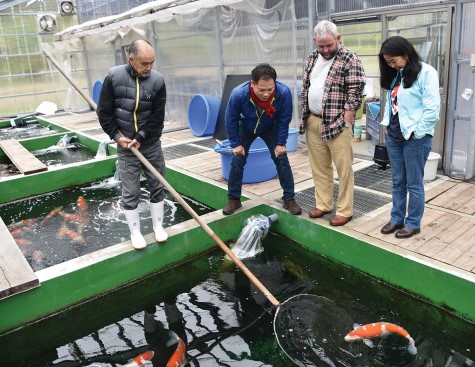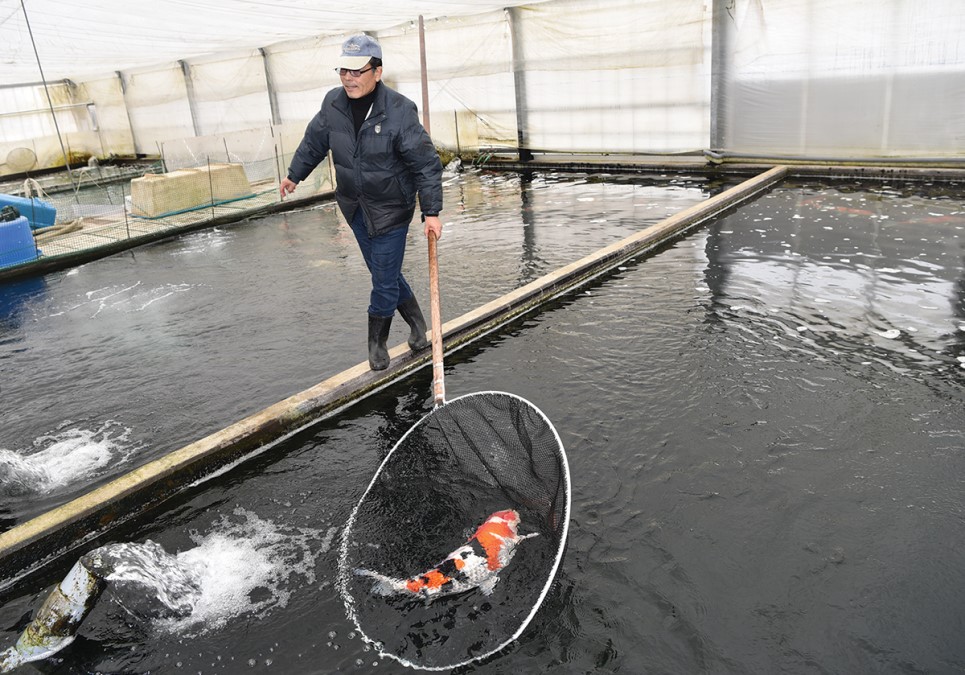
We all know that koi can’t talk. So, what do we mean by the language of koi?
Before you bought your first koi (and became koi kichi), I’m sure you saw the big red and white fish at the koi shows and went home to tell your friends about the beautiful, “big red and white fish,” right?
You might have been confused had you attended the show banquet, where they showed pictures of the winners — perhaps including that big red and white fish — but the judge called it a “kō-haa-koo” (Kohaku). Another winner, the large red and white fish with a little black, was called a “san-kay” (Sanke), but most of the others you couldn’t understand. You attended all the seminars, but the speakers were also speaking a language you couldn’t understand.
My client had that same experience, too!
Studying Abroad

He was smitten by the fish, so he decided he might go to Japan and learn about them! He had heard others talk about their trips to Japan — buying this fish at that dealer and that fish at another. So, he found a dealer at a koi show who was willing to take him along. He didn’t even have a pond yet, and he was already planning his trip to Japan with one of the top guides in the business!
Fast forward six months. With passport in hand and bags packed, he left for the airport to meet one of the top guides in the industry. Decked out in his light clothes and Baja slip-ons, he was off to Niigata to learn the language — or part of it.
There was a car waiting for them when they arrived and took them to the hotel. After a quick shower and meal, they hit the road to meet the first koi dealer.
In the Deep End
Was he saying the fish’s name? Or the price of the fish? My client hadn’t a clue. Finally, he jumped in the conversation and asked about one of the fish. Swallowing his pride, he pointed toward a specific fish and asked what it was called. The dealer looked at him like he had two heads and grinned. “Yamabuki,” he said.

If understanding the names of the winners at the koi show was difficult, grasping what the Japanese koi dealers had to say was going to be nearly impossible. After staying silent for a long time, the dealer pointed to one fish in the middle of a million others and said something with a strong accent. Then he almost immediately jumped to another fish and said something else.
It was a good thing he’d brought his dealer with him as a guide!
“Yamabuki, also known as Yellow Ogon, are koi of a solid-yellow metallic color, or a single-colored yellow fish,” the guide explained.
Now the Japanese lessons had begun! He pointed to another fish that was a whitish silver. “Mukashi Ogon, a fast-growing variety of doitsu, or scaleless fish,” the guide explained.
He then pointed to an orange doitsu with a strong zipper line down its back. “Mizuho Ogon,” the dealer said.
The next dealer had one called “Gin Matsuba” — a white koi with scales that almost looked like netting — and some shiny ones called “Gin Rin” (even though it sounded like “ginling”).
Language of Koi
The language of koi is a unique language, taking select Japanese words and mashing them up with our own mis-dialects, so that everyone in the industry says the same thing — but differently.
In Japanese, the word koi is a homophone for another word that means affection or love. This helps to explain why koi are symbols of love and friendship in Japan. Colored ornamental carp were originally called irokoi (colored carp), hanakoi (floral carp) and moyōkoi (patterned carp).
It starts to get more confusing when you learn the words for colors. For instance, the word for red is hi, like Hi Utsuri, unless you’re describing the different varieties of red: shuiro (vermilion), akaneiro (madder red), enji (dark red), karakurenai (crimson) and hiiro (scarlet) are among of them.
That’s just the beginning. The fish could be aka, as in Aka Bekko, Aka Matsuba or Aka Goromo. My favorites include the Ai Goromo and Budo Goromo, both of which start as red on white fish. It could be beni, as in Beni Kumonryu, Beni Kikokoryu or the Kichi beni (“lipstick on a koi”). Did you know that ryu means dragon, as seen on the end of Kumonryu?
How about the color black? A black koi might be Karasu (kah-rah-soo) or Karasugoi, or it may be a Magoi. According to Full Service Aquatics, “The base stock from which all modern-day koi come are called Magoi. Magoi is what the Japanese and Chinese consider the common carp, known to be a black carp. However, Magoi will typically exhibit a bit of bronze in its coloring and an easily distinguishable orange to white belly color. Magoi is not truly black koi.” (I have seen brown fish called Magoi, too.)
What do we call the black color on a koi? It is called sumi. In the Japanese language, Kuro is also black, as is Kuroi and Kuroba mu. But we don’t apply these to koi? The sumi should be deep, shiny black on the koi. Black is the most unstable color on your fish. The sumi comes up later in life and can disappear as easily as it arrived. One day it is there, and the next day, it is gone!

When showing koi, if Showa, you would like the sumi to look its best. If the sumi is not quite right the month before the show, and it happens to “pop” on the weekend of the show, taking GC (grand champion) or Reserve GC, that’s how the sumi can make or break a champion fish. Of course, the hi and white have to look clean and sharp, too.
What do you call white on your koi? (My head is already spinning.) It is the shiro! On a three-colored fish, such as Sanke, you want to have a shiro body with hi and sumi markings with nice, clear edges. The words koi and Nishikigoi come from the Japanese words for carp and brocaded carp.
The language of koi is ever growing and evolving. My client said his trip was certainly educational, but in the end, he has still decided to call his koi “Goldie,” “Happy,” “Sweetie,” “Baby,” and so forth …


